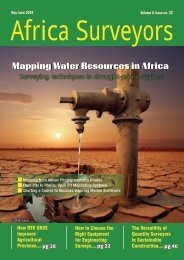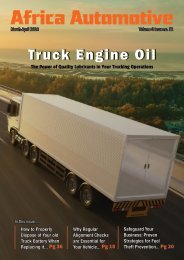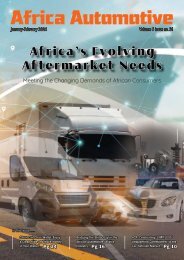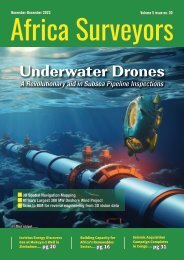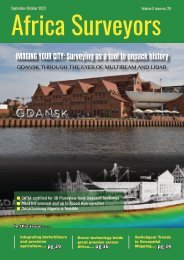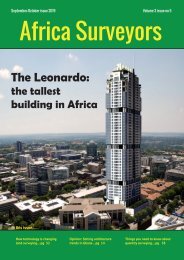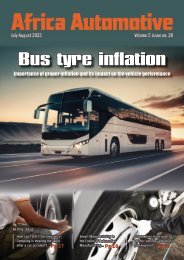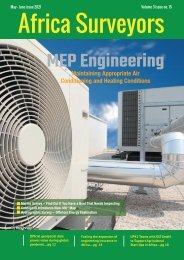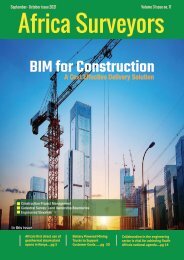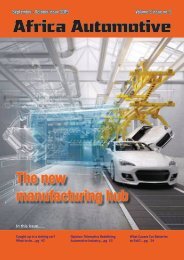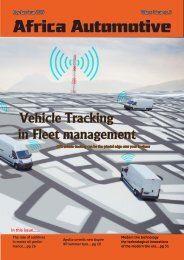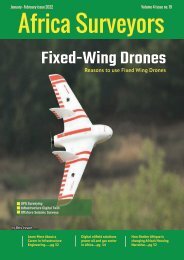Africa Surveyors May-June issue 2023 digital
Africa Surveyors is Africa’s premier source of Surveying, Mapping and Geospatial news and an envoy of surveying products/service for the Construction, Maritime, Onshore & Offshore energy and exploration, Engineering, Oil and Gas, Agricultural and Mining sectors on new solution based trends and technology for the African market.
Africa Surveyors is Africa’s premier source of Surveying, Mapping and Geospatial news and an envoy of surveying products/service for the Construction, Maritime, Onshore & Offshore energy and exploration, Engineering, Oil and Gas, Agricultural and Mining sectors on new solution based trends and technology for the African market.
Create successful ePaper yourself
Turn your PDF publications into a flip-book with our unique Google optimized e-Paper software.
RADIOMETRICS SURVEY<br />
mU and mK, for each of the three energy windows; and their values<br />
are dependent on the size of the crystals and detector altitude.<br />
During a low altitude survey, the presence of atmospheric radon and<br />
cosmic rays can also affect the count rates in each of the three spectral<br />
bands. The effect of these non-geologic sources on the count rates<br />
is primarily due to Compton scattering and the fact that they have a<br />
lower energy than gamma rays originating from the earth's surface.<br />
To reduce the impact of background noise on the spectral windows<br />
and count rates, a special spectrometer called a "differential<br />
spectrometer" is used. The difference between this spectrometer and<br />
the multichannel spectrometer is that it does not use "windows" of<br />
fixed energy width; instead, a narrower range of energy windows<br />
are measured. The detectors are of a larger size, and the light<br />
flash counting rates are much lower than with the multichannel<br />
spectrometer.<br />
The optimum line spacing depends on the survey type and the amount<br />
of detail that is required. For fixed wing surveys, a mean terrain<br />
clearance of 130 metres is recommended, and the line spacing should<br />
be about three times this.<br />
For unmanned aerial geophysical systems (UAS) this spacing is not<br />
as critical, and the distance between the surveyed strip and the<br />
closest point on the ground should not exceed half its diameter. For<br />
this reason a circle of investigation is often used for the strip, which<br />
moves with the aircraft. The main value of low altitude radiometrics<br />
is the ability to map uranium dispersion halos, and to indicate local<br />
anomalies in the U/Th and U/K ratios as "red-balls" or "black balls".<br />
In suitable areas these maps can be useful as aids in geological<br />
interpretation.<br />
“High resolution magnetic and spectrometric surveys on an<br />
airborne platform are routinely being carried out over huge areas in<br />
understanding the subsurface structure and mineral potential and<br />
in narrowing down the areas of interest for subsequent follow-up.<br />
Airborne spectrometric surveys are also being conducted to track the<br />
radioactive plumes in the event of nuclear disasters in atomic power<br />
plants for safety from environmental perspective,” says Ramesh.<br />
Important aspect of Radiometrics survey<br />
The important aspect of radiometric surveys is that they can detect<br />
subtle variations in the natural background radiation. These changes<br />
are generally not detectable from the ground, but can be detected by<br />
using "upward looking" crystals that are shielded from atmospheric<br />
radiation and can therefore monitor these variations in real time<br />
during the survey.<br />
“One important aspect of radiometric surveys is their ability to<br />
provide reliable, consistent, and calibrated data. Variations in lighting<br />
conditions or camera settings can be accounted for and do not<br />
compromise the quality and comparability of the imagery captured<br />
over time,” affirms Susanne Scholz, Application Engineer at Vexcel<br />
Imaging. “Precise calibration of the imaging system is a fundamental<br />
prerequisite to achieving such a high level of reliability. In our<br />
calibration lab, our UltraCam aerial camera systems undergo both<br />
geometric and radiometric calibration processes, transforming them<br />
into precise measurement instruments,” she adds.<br />
Changes in the natural background can lead to errors in the<br />
www.africasurveyorsonline.com<br />
<strong>May</strong>-<strong>June</strong> <strong>issue</strong> l <strong>2023</strong> 21




